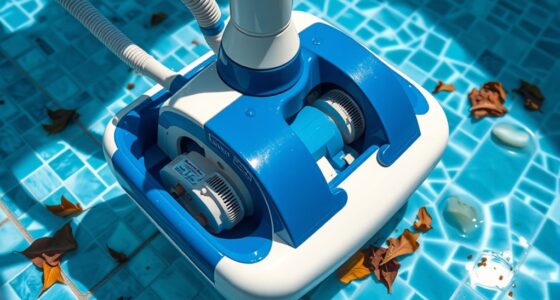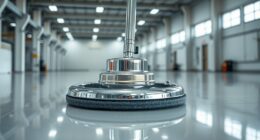Automatic pool cleaners can help remove surface debris and support overall water clarity, but they aren’t enough to fully eliminate algae or clear cloudy water on their own. They rely on your pool’s filtration and chemical balance to work effectively, and severe algae growth or persistent cloudiness often require manual scrubbing or chemical treatments. If you want a clearer pool and better algae control, there’s more to contemplate beyond just the cleaners.
Key Takeaways
- Automatic pool cleaners effectively remove surface debris and dirt but have limited ability to eliminate heavy algae growth.
- They support water clarity by trapping algae spores and debris but require chemical treatments for algae control.
- Regular filter maintenance and proper chemical balancing enhance their effectiveness in cloudy or murky water.
- Robots primarily clean floors and walls; manual scrubbing is needed for stubborn algae mats and stains.
- Combining robotic cleaning with manual and chemical treatments provides the most comprehensive solution for algae and cloudiness.
How Do Automatic Pool Cleaners Work?
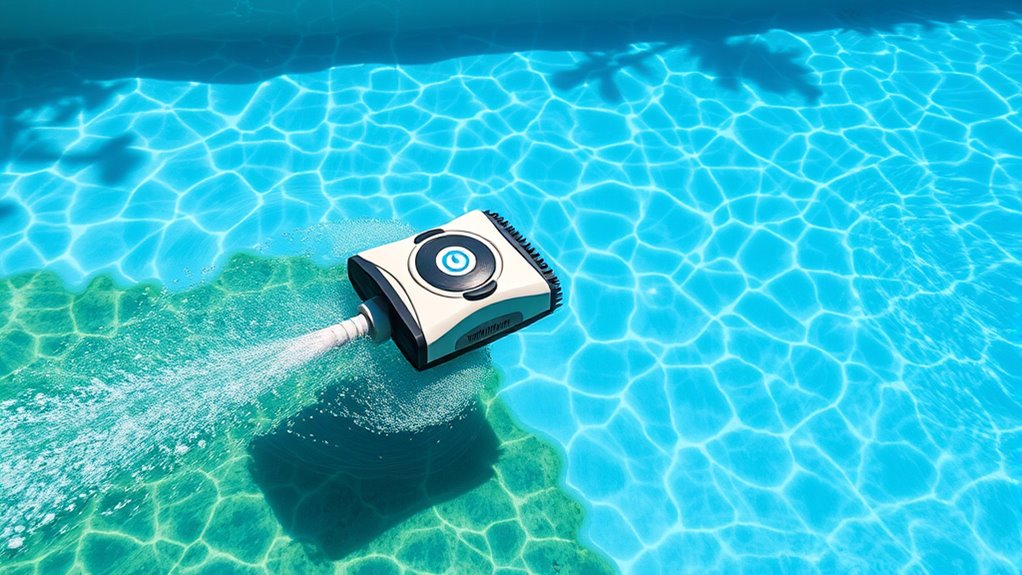
Ever wondered how automatic pool cleaners keep your pool spotless without much effort? They work by moving around your pool, using a combination of brushes, suction, and filtration. These cleaners rely on your pool’s pump and filter system to pick up dirt, debris, and algae spores from the surface and bottom. Pool chemistry plays a role here—balanced chemicals minimize algae growth and debris buildup, making cleaning easier. Sun exposure can cause algae and organic matter to multiply faster, so regular cleaning helps manage these effects. Some models navigate using sensors or cables, ensuring thorough coverage. Once activated, your cleaner efficiently tackles dirt, making pool maintenance simpler. This seamless process keeps your water clear, reducing your workload and enhancing your swimming experience.
Effectiveness Against Algae Growth
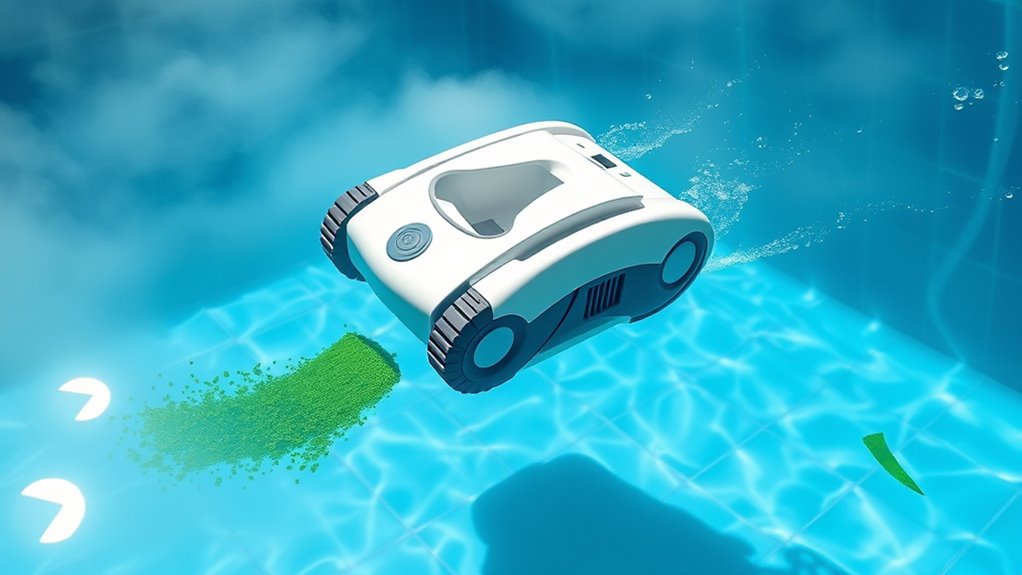
Automatic pool cleaners can markedly reduce algae growth by removing organic matter and debris that serve as nutrients for algae. While they help keep the pool surface clean, chemical treatments are essential for controlling algae at the chemical level. Regular sanitization with algaecides and chlorine ensures algae don’t take hold. Additionally, your filtration system plays an indispensable role by trapping smaller particles and preventing algae spores from circulating. A well-maintained filtration system works in tandem with the cleaner, improving overall effectiveness against algae. Proper digital literacy programs can help pool owners better understand maintenance routines and troubleshooting. Furthermore, understanding the different types of chemicals used in pool maintenance can aid in selecting the most effective treatments. Using the correct pool maintenance techniques is vital for preventing algae from returning quickly. Incorporating proper chemical balance into your routine can also significantly inhibit algae growth and promote clearer water. Maintaining consistent circulation and filtration enhances the overall pool health, reducing the likelihood of algae outbreaks. However, automatic cleaners alone won’t eliminate algae entirely; integrating proper chemical treatments and maintaining a robust filtration system is key to keeping your pool clear and algae-free. This combined approach maximizes your pool’s cleanliness and health.
Handling Cloudy and Murky Water
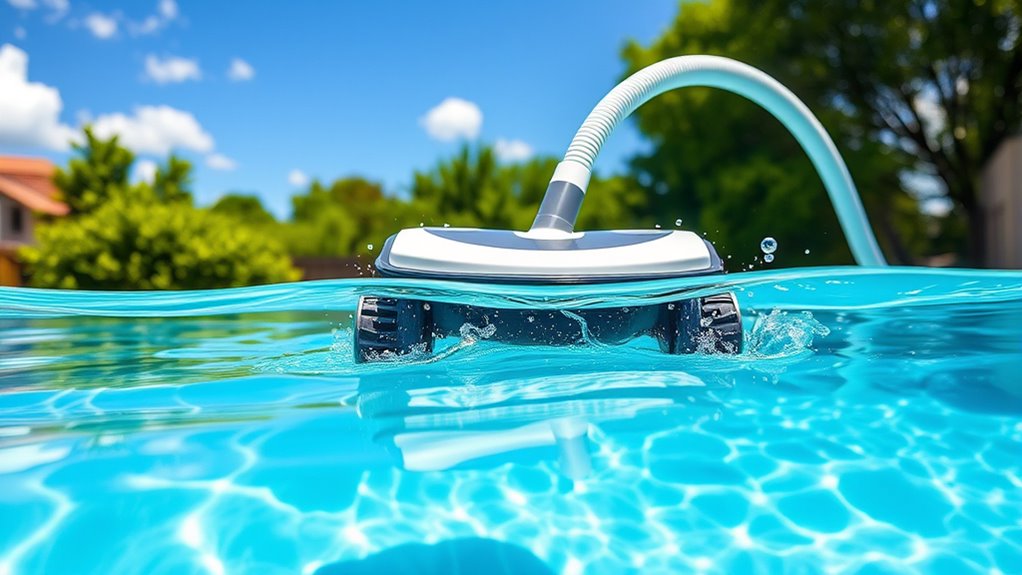
When your pool water becomes cloudy or murky, automatic cleaners can help remove debris and improve clarity. Their debris collection features make it easier to clear out leaves, dirt, and other particles. Plus, some models are equipped to target algae, helping restore your pool’s sparkling condition. Regular use of an automatic cleaner can also prevent buildup that contributes to water cloudiness. Water circulation and filtration are essential factors in maintaining clear pool water and can enhance the effectiveness of automatic cleaners. Proper filter maintenance ensures that the filtration system operates efficiently, further supporting clear water. Additionally, understanding how tuning the pool’s filtration system can optimize water clarity is vital for long-term maintenance. Implementing proper asset division strategies when managing pool equipment upgrades can also help distribute costs effectively for ongoing upkeep. Maintaining an optimal chemical balance is crucial for preventing algae growth and ensuring water remains clear over time.
Effectiveness in Clearing Debris
While cloudy and murky water can pose challenges for pool cleaners, many models are designed to tackle debris effectively even in less-than-clear conditions. Automatic pool cleaners are equipped with powerful suction and brushes that pick up leaves, dirt, and small particles efficiently. To enhance their performance, regular chemical treatments help break down organic matter, making debris easier to remove. Maintaining your pool cover also prevents debris buildup, reducing the workload for your cleaner. Proper chemical balance is essential for optimizing the effectiveness of the cleaner and maintaining water clarity. Additionally, utilizing proper filtration techniques can improve water clarity and facilitate debris removal. Effective circulation helps distribute chemicals evenly and supports filtration, further aiding in clearing cloudy water. While it might take a bit more time, a well-maintained pool combined with a quality automatic cleaner can notably improve water clarity and cleanliness, handling debris effectively regardless of how cloudy or murky the water appears.
Algae Removal Capabilities
Handling algae in cloudy or murky water can be challenging, but many automatic pool cleaners are equipped to address this issue effectively. While these cleaners can scrub surfaces and vacuum debris, chemical treatments are often necessary to fully eradicate algae. Combining an automatic cleaner with algaecides or chlorine boosts results. Additionally, pool cover options can prevent algae growth by limiting sunlight exposure, reducing the need for frequent chemical use. A thorough brushing of the pool walls and floor can also improve algae removal efficiency for efficient cleaning. Regular monitoring of water chemistry and filtration system maintenance can further enhance algae control efforts, especially when optimized for water clarity and circulation. Proper water testing techniques are essential to identify and correct imbalances that promote algae growth. Moreover, choosing an automatic cleaner with advanced contaminant detection capabilities can further optimize algae removal and maintain water quality.
Types of Robotic Cleaners Suitable for Problematic Pools

For pools with challenging features like uneven surfaces, tight corners, or stubborn debris, robotic cleaners designed specifically for problematic pools can make a significant difference. These models are built to navigate complex layouts, ensuring thorough cleaning and better maintenance of water chemistry. When choosing the right robotic cleaner, consider features that enhance pool safety and efficiency. Look for models with strong suction power, adjustable cleaning modes, and smart navigation systems. They help prevent algae buildup and keep water clear, reducing the need for harsh chemicals. Additionally, some robotic cleaners come with specialized brushes or sensors that target algae-prone areas. Investing in the right type ensures your pool stays safe, clean, and inviting, even under tough conditions. Regular maintenance and proper filter care can further improve their effectiveness, especially in algae prevention, and keeping water clear. Incorporating models with advanced navigation technology can significantly improve coverage and cleaning performance in complex pool designs. Proper maintenance routines can also extend the lifespan of your robotic cleaner and ensure consistent results, supported by AI-enabled feedback systems that optimize cleaning cycles.
Limitations of Automatic Cleaners in Tough Conditions

Despite advances in robotic cleaner technology, tough conditions can still challenge their effectiveness. When your pool has heavy algae growth or persistent cloudiness, automatic cleaners might struggle to keep up. Chemical treatments are often necessary to break down algae and clarify water, but robots can only remove surface debris and some algae on pool floors and walls. They aren’t equipped to handle thick algae mats or stubborn stains that require manual scrubbing. Additionally, debris like leaves or large algae clumps can clog the filters or get stuck, reducing efficiency. So, while automatic cleaners are helpful for routine maintenance, they have limitations in severe conditions. You’ll still need to rely on chemical treatments and manual scrubbing to achieve crystal-clear water in challenging situations. Proper pool maintenance techniques are essential to manage algae and cloudiness effectively, especially in tough conditions. Regularly monitoring water chemistry helps prevent algae outbreaks from developing into severe problems, and understanding the limitations of automatic cleaners can help set realistic expectations for their performance. For persistent issues, considering advanced filtration systems can provide additional support in maintaining water clarity.
Tips for Enhancing Cleaning Performance

To get the most out of your automatic pool cleaner, regularly prepare your pool environment to support ideal performance. Properly balanced pool chemicals prevent algae buildup and cloudy water, making cleaning more effective. Maintaining your filter ensures debris is removed efficiently, reducing strain on the cleaner. Additionally, keep an eye on water levels and remove large debris manually before running your cleaner. Regularly check and adjust pool chemicals to maintain proper pH and sanitizer levels. Clean or replace filters as needed to prevent clogging and maximize suction power. Consistent filter maintenance and chemical balancing create an excellent environment for your cleaner, allowing it to tackle dirt, algae, and cloudiness more effectively. Algae prevention is essential for keeping your pool clear and reducing the workload on your automatic cleaner.
Combining Manual and Robotic Cleaning Strategies

Combining manual and robotic cleaning strategies maximizes your pool’s cleanliness and reduces the workload. Manual brushing and skimming target areas robotic cleaners might miss, especially along the waterline or in corners. Regularly checking chemical balancing guarantees algae and cloudiness don’t develop, making robotic cleaning more effective. Using a pool cover when the pool isn’t in use minimizes debris and algae growth, easing your overall maintenance. Here’s a quick overview:
| Manual Cleaning | Robotic Cleaning |
|---|---|
| Targets stubborn algae | Cleans floors and walls automatically |
| Requires hands-on effort | Saves time and energy |
| Focuses on waterline | Maintains overall clarity |
| Needs chemical checks | Operates independently |
| Complements pool cover use | Reduces debris accumulation |
This combined approach keeps your pool pristine with less hassle.
Making the Right Choice for Your Pool Maintenance

Choosing the right pool maintenance approach depends on your specific needs, budget, and schedule. To keep your pool clear and healthy, consider how often you’ll perform seasonal maintenance and monitor pool chemistry. An effective maintenance plan balances automation with manual checks to prevent algae and cloudiness. When selecting tools or systems, think about your pool’s size, debris load, and your ability to handle chemical adjustments.
Selecting the right maintenance approach depends on your needs, budget, and schedule for a healthy, inviting pool.
- Regularly test and adjust pool chemistry to prevent algae growth
- Schedule seasonal maintenance to address changing weather conditions
- Choose between robotic or manual cleaning based on your availability
- Invest in a system that simplifies balancing chemicals and filtering
Making these choices guarantees your pool stays inviting, safe, and easy to maintain year-round.
Frequently Asked Questions
Can Automatic Pool Cleaners Remove Algae Completely?
Automatic pool cleaners can help remove some algae, but they often can’t eliminate it completely. To prevent algae buildup, you should regularly perform filter maintenance and keep your pool chemically balanced. While these cleaners can remove debris and dirt, algae can cling to surfaces and grow in hidden spots. Consistent algae prevention and proper maintenance are essential for a crystal-clear pool, supplementing the cleaner’s efforts for the best results.
How Often Should I Run My Robotic Cleaner During Algae Blooms?
During algae blooms, you should run your robotic cleaner daily to keep debris on the surface and bottom. Make certain your pool chemical balancing is correct, especially chlorine levels, to prevent algae growth. Regular filter maintenance is essential to guarantee your cleaner works efficiently. By combining frequent cleaning with proper chemical balance and filter upkeep, you’ll control the algae and keep your pool clear and inviting.
Do Robotic Cleaners Require Special Filters for Algae Removal?
Your robotic cleaner is a superhero, but even heroes need the right tools! It doesn’t require special filters for algae removal, but regular filter maintenance is key for algae prevention. Upgrading to fine or algae-specific filters can boost its algae-fighting powers. Keep your filters clean, and your pool stays crystal-clear. Think of it as giving your cleaner the superpower it needs to vanquish algae and keep your water pristine!
Can Automatic Cleaners Prevent Algae From Returning?
Automatic pool cleaners can help prevent algae from returning, but they’re not a complete solution on their own. You need to maintain proper pool chemistry and make certain your filtration systems are working efficiently. Regularly brushing and vacuuming, along with balancing pH levels and keeping the filter clean, will make your cleaner more effective. By combining these efforts, you’ll reduce algae growth and keep your pool clear longer.
Are Robotic Pool Cleaners Effective in Removing Algae From Cloudy Water?
Think of your pool as a stubborn stain on your favorite shirt—you want it gone fast. Robotic pool cleaners can be quite effective in algae removal from cloudy water, but they’re not magic. They help scrub surfaces and circulate water, aiding filter maintenance. However, for heavy algae blooms, you’ll need to combine their use with proper chemical treatments for thorough cleaning and crystal-clear results.
Conclusion
Think of your pool as a crystal-clear lake, inviting and pristine. Automatic cleaners are your loyal boats, sailing across the surface, fighting algae and murk. While they’re great at maintaining, sometimes you need to steer manually through rough waters. By combining their steady voyage with your hands-on efforts, you’ll keep your pool a sparkling oasis—an inviting mirror of tranquility, reflecting your care and dedication in every shimmering wave.



